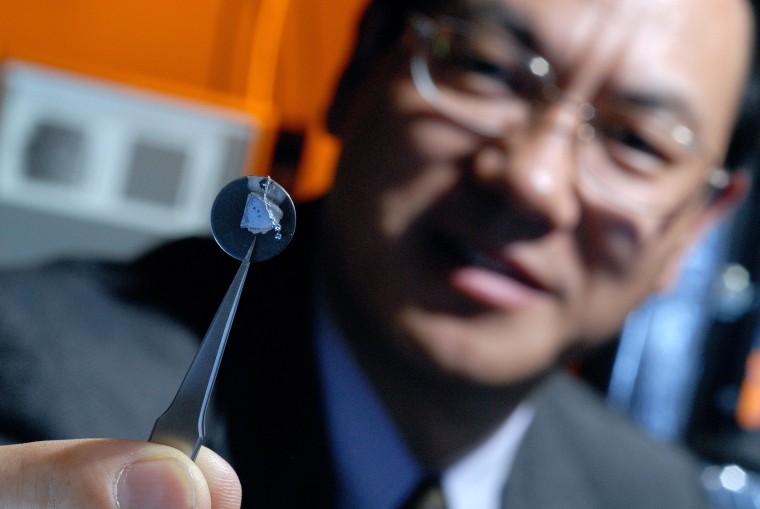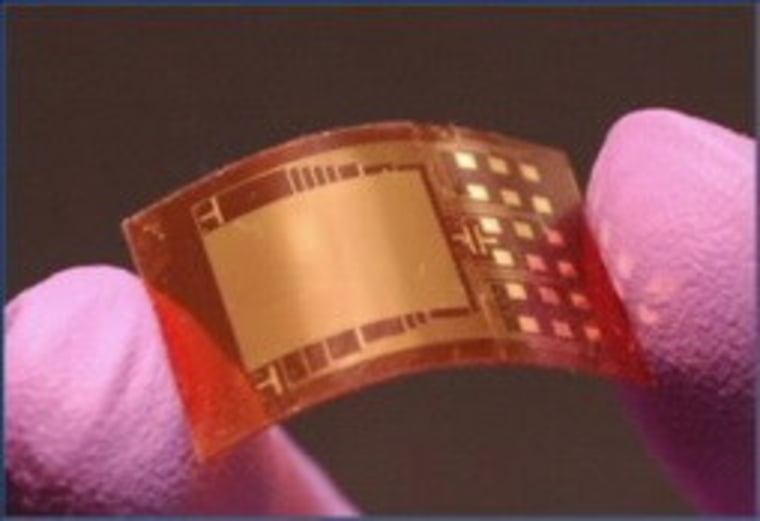
Someday, your pulse could provide all the power you'll need for your iPod. At least that's the promise held out by researchers who say they've developed the first commercially viable nanogenerator.
The nanogenerator is actually a flexible chip containing millions of zinc oxide nanowires. The important thing about these wires is that when you flex them, they create a tiny bit of electric current. This phenomenon, known as the piezoelectric effect, was discovered more than a century ago and plays an essential role in lots of electronic devices.
Suppose you could deposit millions of power-generating nanowires in just the right arrangement, within layers of polymer material, and suppose you could flex them in just the right way to capture and combine the resulting electricity. That's what Georgia Tech's Zhong Lin Wang and his colleagues have been working on for the past six years.
Their latest prototype chips are about a quarter the size of a postage stamp, but when you stack five of the chips on top of each other like a sandwich, you can produce 1 microampere of current at 3 volts — which is equivalent to the voltage of two AA batteries. And you can produce it just by squeezing the chips together with your fingers.
That's enough power to light up an LED bulb or a liquid crystal display on a calculator or computer.
"While a few volts may not seem like much, it has grown by leaps and bounds over previous versions of the nanogenerator," Wang said in a news release from the American Chemical Society. "Additional nanowires and more nanogenerators, stacked together, could produce enough energy for powering larger electronics, such as an iPod or charging a cell phone."

During a presentation at this week's ACS national meeting in Anaheim, Calif., Wang said the latest device puts out thousands of times more power and 150 times more voltage than the early prototypes.
"This development represents a milestone toward producing portable electronics that can be powered by body movements without the use of batteries or electrical outlets," he said. "Our nanogenerators are poised to change lives in the future. Their potential is only limited by one's imagination."
If Wang were merely talking about charging up iPods by pinching your fingers together, that wouldn't create much of a stir. But he suggests that piezoelectric nanogenerators could be placed into the soles of your shoes to power up wearable electronic devices (fitness monitors, for example). They could be implanted inside the body, using the energy of your heartbeat to keep an insulin pump going. They could be woven into wind-powered environmental sensors that flap in the breeze, or built into the automotive tires to produce an extra jolt of electricity for your car's accessories.
But all those applications are still a little farther down the road. Wang and his colleagues still have to find a way to make further improvements in power output, and then find a company to produce the devices commercially. Wang estimates that the first nanogenerators will make their appearance on the market in the next three to five years, most likely as power sources for environmental sensors or infrastructure monitoring devices.
More about tiny power sources:
- How Wang's device could power micro-robots
- Micro-motor runs on bacteria power
- Transistor merges man and machine
- Could sperm power nanobots?
Funding for the nanogenerator research comes from the Pentagon's Defense Advanced Research Projects Agency, the U.S. Department of Energy, the National Institutes of Health, the National Science Foundation and the U.S. Air Force.
Join the Cosmic Log community by clicking the "like" button on our Facebook page or by following msnbc.com science editor Alan Boyle as b0yle on Twitter. To learn more about my book on Pluto and the search for planets, check out the website for "The Case for Pluto."
